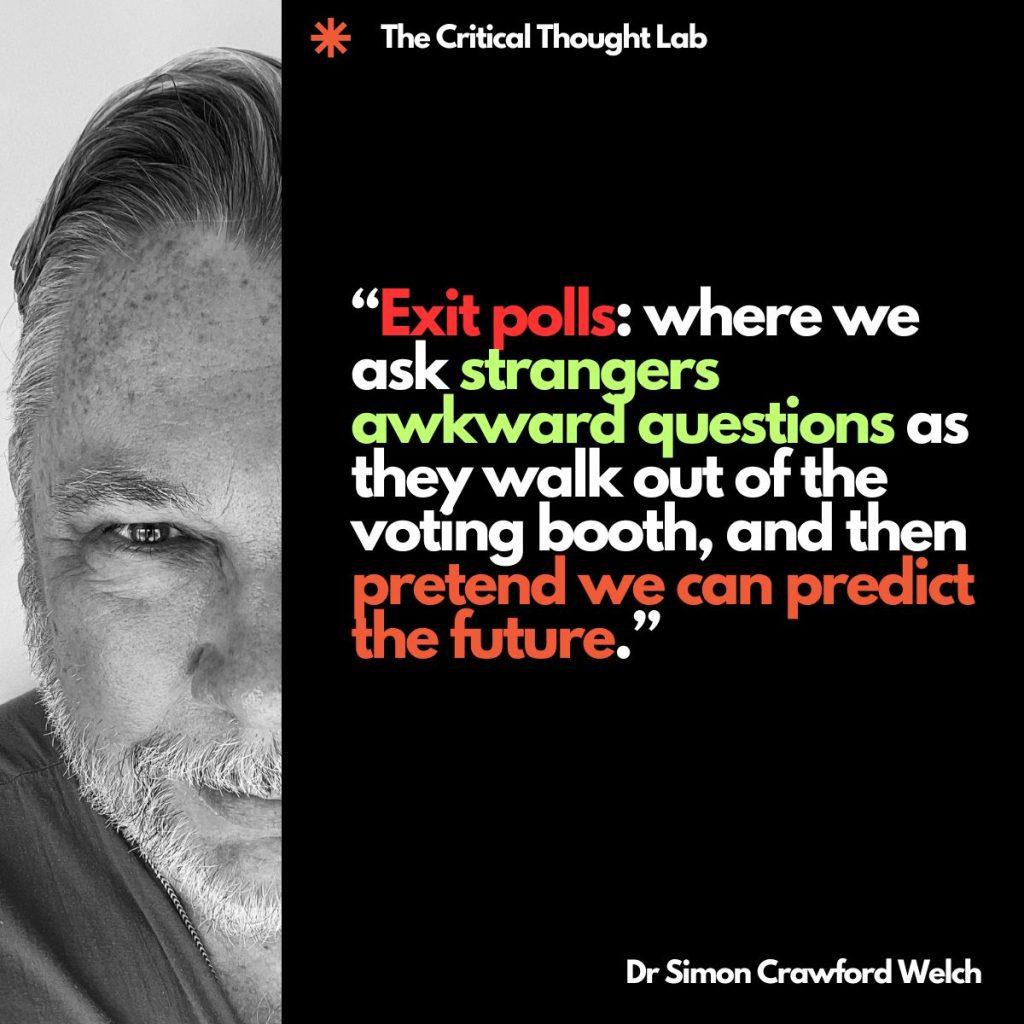The Reliability and Validity of Exit Polling in the Upcoming U.S. Presidential Election
by
Dr. Simon Crawford-Welch
Founder, The Critical Thought Lab
www.linkedin.com/in/simoncrawfordwelch
Author of
“American Chasms: Essays on the Divided States of America” (Available on Amazon)

Exit polling has long been a critical part of election coverage, offering real-time insight into how different voter demographics cast their ballots. These polls, conducted as voters leave polling stations, have been used to predict outcomes, analyze voter behavior, and provide the public and media with valuable election night data. However, in recent years, questions surrounding the reliability and validity of exit polls have grown. With evolving voting practices, such as the rise of early voting and absentee ballots, and increasing distrust in polling, can exit polls still be trusted?
What Is Exit Polling? Exit polling refers to the process of surveying voters immediately after they cast their ballots at polling stations. Trained pollsters ask voters questions about who they voted for, their reasons for voting, and demographic information like age, gender, and income. These polls aim to capture the “pulse” of the electorate in real time.
Exit polls serve multiple purposes:
- Predicting outcomes: These polls offer early insights into election results before the official count is complete.
- Understanding voter demographics: They help identify trends based on voter age, ethnicity, income level, and more.
- Analyzing voter behavior: Exit polls provide data on what motivated voters, how they made their choices, and whether issues like the economy, healthcare, or immigration played a role.
Exit polls also play a vital role in media coverage on election night, providing early projections and informing live broadcasts and analysis.
The History of Exit Polling in U.S. Elections: Exit polling has been a staple in U.S. elections since the 1960s. Initially developed by social scientists to provide real-time analysis of voter behavior, exit polls gained prominence in the media during the 1970s and 1980s, helping networks make election night projections before official results were tallied.
There have been both successes and failures in the history of exit polling. In some elections, such as the 1980 race between Ronald Reagan and Jimmy Carter, exit polls accurately predicted landslide victories. However, exit polling has also faced controversies, most notably in the 2000 election between George W. Bush and Al Gore, where exit polls wrongly suggested a win for Gore in Florida, only for the state to become the epicenter of a recount battle. Similarly, in 2016, exit polls underestimated Donald Trump’s support, contributing to widespread surprise at his victory.
These moments of miscalculation highlight both the power and limitations of exit polls.
Reliability of Exit Polling: The reliability of exit polling depends heavily on proper sampling techniques. Pollsters need to ensure that the sample of voters they survey is representative of the actual voting population. If certain groups are underrepresented (e.g., rural voters, younger voters), the results can be skewed. Ensuring that pollsters interview voters from diverse polling locations is critical to improving reliability.
As with any survey, exit polls come with a margin of error—a statistical measure that shows how much the results might differ from the actual outcome. A small margin of error suggests the results are more reliable, while a large one indicates more uncertainty. Pollsters account for this, but on election night, slight differences in a close race can lead to misleading projections.
Response bias can also undermine the reliability of exit polls. Some voters may refuse to participate, and if non-responders share common characteristics—such as higher support for a particular candidate—this can skew results. Additionally, some voters may not accurately disclose their choice, particularly if they feel their vote is unpopular or controversial. This phenomenon was evident in 2016, where “shy Trump voters” likely skewed polling results.
Perhaps the biggest challenge to exit polling in recent elections is the rise of early voting and mail-in ballots. In some states, a significant portion of the electorate votes before election day, making traditional exit polling less effective. Pollsters can’t capture these votes, leading to incomplete data and reducing the reliability of exit polls as an indicator of total election results.
Validity of Exit Polling: Construct validity refers to how well exit polls capture the data they are intended to measure. Ideally, exit polls should accurately reflect voter preferences and demographic information. However, pollsters sometimes face challenges in capturing the full spectrum of voter motivations or accurately reporting voter behavior due to social desirability bias or unclear questioning.
Predictive validity measures how well exit polls can predict final election outcomes. While exit polls have been successful in some elections, they’ve also fallen short in high-profile cases (e.g., 2000, 2016). Factors such as last-minute voter decisions, poorly sampled regions, and shifts in voter turnout can diminish the predictive accuracy of exit polls.
External validity looks at whether the results of exit polls can be generalized across different populations. The U.S. electorate is diverse, and capturing accurate data from various demographic groups (urban vs. rural, young vs. old, etc.) is a challenge. Pollsters need to ensure their methods reflect this diversity to avoid missing key voting trends.
In recent years, there have been changes in voter behavior, including increased polarization and party-line voting. This shift may challenge the validity of exit polls, as traditional predictors of voter behavior—such as income level or education—are no longer as reliable in predicting voter choice.
Challenges in Exit Polling for the 2024 U.S. Presidential Election: The increasing popularity of early voting and mail-in ballots presents a significant challenge for exit pollsters. In some states, up to half or more of the electorate may vote before election day, making traditional exit polls less comprehensive. To maintain accuracy, pollsters must find ways to capture the preferences of early voters through pre-election surveys or other methods.
The U.S. electorate is more diverse than ever, with growing numbers of younger voters, ethnic minorities, and first-time voters. Accurately polling such a diverse group presents unique challenges. For instance, language barriers, varied political priorities, and differing voting habits can all compl
icate the process of gathering representative data.
Recent high-profile polling errors—such as the misses in the 2016 and 2020 elections—have contributed to growing public mistrust in polling. This mistrust could affect voter participation in exit polls, with some voters choosing not to engage with pollsters at all. If this trend continues, it could reduce the accuracy of the data collected.
Digital technology and social media have transformed how voters access information and make decisions. As these technologies continue to evolve, exit pollsters must consider how online discourse, misinformation, and targeted political ads influence voter behavior. The challenge is adapting traditional exit polling methods to account for this shift.
Exit Polls and Media Coverage: Exit polls play a major role in election night reporting. Media outlets rely on early polling data to make projections and provide viewers with real-time insights into the election’s likely outcome. These polls help shape the narrative and provide context for understanding the vote.
In some cases, exit polls have led to premature projections, which can impact the public’s perception of the race. A notable example is the 2000 Bush-Gore election, where incorrect projections in Florida based on early polling data created confusion and undermined confidence in the election process.
There are also ethical concerns around how exit poll data is presented. Media outlets must balance the public’s desire for real-time information with the responsibility to avoid misleading voters. Care must be taken to present exit poll results with appropriate caution, particularly in close races.
How Exit Polls Can Be Improved for the 2024 Election: Pollsters should use pre-election surveys to account for early and absentee voters, capturing a more comprehensive picture of voter preferences, and they need to refine their methods to ensure that diverse voter groups are adequately represented.
Leveraging predictive analytics and AI can help improve the accuracy of exit polling, allowing pollsters to account for real-time shifts in voter behavior.
Looking Ahead: The Future of Exit Polling: As voting practices evolve, the future of exit polling may depend on integrating new methodologies that blend traditional polling with big data analytics. Social media sentiment analysis, predictive modeling, and even real-time voter engagement tracking could all play a role in the future of election polling. The challenge for exit polls will be to remain relevant in a world where voter behavior and technology are rapidly changing.
Interested in learning more? Get a copy of Simon’s newly release book, “American Chasms: Essays on the Divided States of America” (Available on Amazon).



